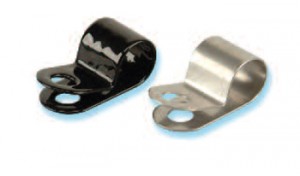 If you’re looking for a solution that’ll keep your cables on lockdown, cable clamps are the way to go. You’ll basically be arresting your cables – imagine a prisoner handcuffed to the wall of his prison cell. You’ll always have the key to let him out but it’s a lot safer with him handcuffed to the wall. Cable clamps secure cables or tubing into place, on whatever surface you choose. After putting your cables into the clamp, you’ll use a screw, arrow clip, or push-in fastener to secure them. There are various types of cable clamps you can choose from – here are some details about the major ones.
If you’re looking for a solution that’ll keep your cables on lockdown, cable clamps are the way to go. You’ll basically be arresting your cables – imagine a prisoner handcuffed to the wall of his prison cell. You’ll always have the key to let him out but it’s a lot safer with him handcuffed to the wall. Cable clamps secure cables or tubing into place, on whatever surface you choose. After putting your cables into the clamp, you’ll use a screw, arrow clip, or push-in fastener to secure them. There are various types of cable clamps you can choose from – here are some details about the major ones.
Nylon Cable Clamps
Nylon cable clamps have the advantage of being resistant to corrosion. They’ll resist corrosion that would normally be caused by salt water, weak acids, gasoline, alcohol, oil, grease, and common solvents.
Push Lock Style Nylon Cable Clamps
These are a subset of nylon cable clamps and have the advantage of not requiring any additional hardware to secure your cables in place – no screw, arrow clip, or push-in fastener is necessary. They has a built in “lock” that secures your cables quickly and easily. They are also resistant to corrosion.
Snap Lock Style Nylon Cable Clamps
Another subset of nylon cable clamps, these make installation even easier, allowing you to position your wires perfectly before clamping. Another benefit is they can easily be removed and reused. As with the other nylon cable clamps, they’re resistant to corrosion.
Stainless Steel Cable Clamps
These are heavier duty cable clamps that you should use if your wiring is in an outdoor or harsh environment. The smooth edges of these stainless steel cable clamps will not damage the insulation of your cables. Make sure to pay attention to the quality of the stainless steel used to construct these cable clamps. It should be 304 stainless steel, which is corrosion resistant. Also, pay attention to what the clamps are coated with, if anything. What you’re looking for is it to be coated with polyolefin, which will give it flexibility in low temperatures and make it ideal for handling the electricity flowing through your wires. And as an added bonus, you can eat off of them – they’re FDA approved for food contact.
Hose Clamps
This unique clamp uses a double row of teeth to secure hoses in place – think two alligators kissing. As the name implies, they are only for hoses so this isn’t a solution for your cables or tubing. Hose clamps make it very easy to position the hose before actually clamping it in place. They’re reusable, tough, lightweight, and resistant to corrosion. For hoses, these are what you want.
Those are the major types of cable clamps, as well as a bonus unadvertised hose clamp. Use the benefits listed above to decide which cable clamps are best for your purposes. Consider the location where you’ll use the clamps, the need for reuse if you have any, and how secure you want the clamps to be.
